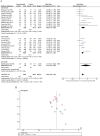Sequential embryo transfer efficacy in enhancing pregnancy outcomes: a systematic review and meta-analysis
- PMID: 40399707
- PMCID: PMC12356793
- DOI: 10.1007/s10815-025-03487-5
Sequential embryo transfer efficacy in enhancing pregnancy outcomes: a systematic review and meta-analysis
Abstract
Background: Sequential embryo transfer (SEQET) can increase the availability of embryos at various stages within the implantation window, thus improving the outcomes of assisted conception. This research seeks to analyze and synthesize clinical information on the influence of SEQET on in vitro fertilization (IVF) embryo transfer outcomes.
Methods: The literature search was done through four databases, which are Pubmed, Web of Science, Scopus, and Cochrane. The inclusion criteria are clinical trials or observational studies comparing sequential embryo transfer (cleavage and blastocyst) to single-day embryo transfer (cleavage or blastocyst) in women undergoing IVF. Data was collected from the included studies and analyzed by RevMan software.
Results: Twenty-three studies fulfilled the criteria for inclusion in this study. We found that SEQET showed significant improvement in clinical and chemical pregnancy rates (P < 0.00001) in comparison to the cleavage embryo transfer (CET) group. Moreover, implantation rates (P = 0.002) and live births (P = 0.006) were significantly greater. In comparing SEQET to blastocyst transfer, SEQET was associated with a significant increase in the clinical pregnancy rate (P = 0.003).
Conclusion: This research discovered that sequential embryo transfer significantly enhanced live birth, clinical pregnancy, chemical pregnancy, and implantation rates compared to cleavage transfer. SEQET also improved clinical pregnancy rates compared to blastocyst transfer. However, there was no significant difference between the two groups in terms of live birth, implantation rates, or miscarriages.
Keywords: Cleavage transfer; IVF; Sequential embryo transfer.
© 2025. The Author(s).
Conflict of interest statement
Declarations. Ethics approval: N/A. Consent to participate: N/A. Consent for publication: N/A. Conflict of interest: The authors declare no competing interests.
Figures






References
-
- Steptoe P, Edwards R. Birth after the reimplantation of a human embryo. Lancet. 1978;2(8085):366. - PubMed
-
- Mitri F, Nayot D, Casper RF, Bentov Y. Current tools for the optimization of embryo transfer technique for recurrent implantation failure. Minerva Ginecologica. 2016;68(4):431–49. - PubMed
-
- Busnelli A, Reschini M, Cardellicchio L, Vegetti W, Somigliana E, Vercellini P. How common is real repeated implantation failure? An indirect estimate of the prevalence. Reprod Biomed Online. 2020;40(1):91–7. - PubMed
-
- Coughlan C, Walters S, Ledger W, Li TC. A comparison of psychological stress among women with and without reproductive failure. Int J Gynecol Obstet. 2014;124(2):143–7. 10.1016/j.ijgo.2013.08.006. - PubMed
Publication types
MeSH terms
LinkOut - more resources
Full Text Sources
Medical

